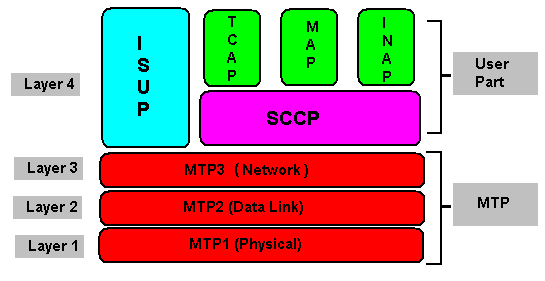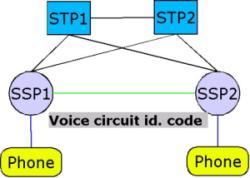Tech Stuff - SS7 Protocols
ZYTRAX now offers SIGTRAN and SS7 training.
Contents
- SS7 Overview
- SS7 Signaling Points
- SS7 Stack
- ISUP - Call Setup Procedures
- SCCP Overview
- TCAP Overview
- Global Title Translation (GTT)
- SS7 & SIGTRAN Glossary
Common Channel Signaling System #7 (SS7)
Common Channel Signaling System #7 (SS7) separates the information required to set up and manage telephone calls in the Public Switched Telephone Network (PSTN) onto a separate packet switched network (The Signaling Network) rather than use the same circuit switched network that the telephone call is made on (The Voice Network). This technique is commonly called out-of-band signaling and contrasts with earlier in-band techniques (Channel Associated Signaling - CAS) which used MF tones. The SS7 network consists of Signaling Points.

Figure 1.0
Signaling Points
SSP = Service Switching Point
STP = Signal Transfer Point: Usually deployed in pairs in case of failure
SCP = Service Control Point: Usually deployed in pairs in case of failures.

Signaling Points (SPs)
All nodes in the SS7 network are called Signaling Points (SPs). Each SP is identified by a unique address called a Point Code (PC). SPs have the ability to read a Point Code and determine if the message is for that node and the ability to route SS7 messages to another SP. The three types of Signaling Points are:
Links - SP Interconnection
All SPs (signalling points) are connected using (typically) pairs of Links. Each Link type is identificed with a letter as defined below:
- Type A - Access Links (used to connect SSPs to STPs or STPs to SCPs).
- Type B - Bridge Links (used to connect paired STPs to other paired STPs).
- Type C - Cross Links (used to connect paired STPs).
- Type D - Diagonal Links (used to connect paired STPs at one in the hierarchy to paired STPs at another level in the hierarchy).
- Type E - Extended Links (used to connect SSPs to alternate or remote STPs for increased resiliance and load sharing).
- Type F - Fully Associated Links (used to connect SSPs when significant traffic flows between them).
All links use the same physical connections (typically DS0A - 56K bit/s or DS1 (T1)). The letter designation allows differing congestion and recovery treatment.

The SS7 Protocol Stack
The standard SS7 protocol has 4 levels (layers) as defined in the OSI 7 Layer Model. The levels 1 to 3 constitute the Message Transfer Part (MTP) and level 4 is the User Part (Transport Layer in OSI).

The SS7 Protocol Stack Model
MTP1 = Message Transfer Part 1
MTP2 = Message Transfer Part 2
MTP3 = Message Transfer Part 3
SCCP = Signaling Connection Control Part
TCAP = Transaction Capabilities Application Part
MAP = Mobile Application Part
INAP = Intelligent Network Application Part
ISUP = ISDN User Part
NOTE: TCAP, MAP and INAP are examples of services that use SCCP (list in SS7 glossary).
Blocks and Packets
SS7 uses three types of packets, called Signal Units (SUs) only one of which carries data. The Fill-in Signal Unit (FISU) is sent when the link is idle and allows the end-points to monitor signal quality and link integrity. The Link Status Signal Unit (LSSU) is sent when a link error occurs. Message Signal Units (MSU) carry protocol payloads such as ISUP, MAP etc.
Message Transfer Parts
The MTP acts as the carrier for all SS7 messages providing reliable transfer from one SP to another (node-to-node) with error detection and correction. MTP covers levels 1-3 in the OSI stack. [MTP ITU-T Specs: Q.701-Q.705 ANSI: T1.111.1 - T1.111.8]
MTP1 (physical layer): ITU-T Specs: Q.702
MTP1 is equivalent to the physical layer of the OSI model
MTP1 defines the physical and electrical characteristics of the signaling link.
The physical interfaces defined for SS7 include E-1 (2048kb/s; 3264kb/s channels), DS-1(1544kb/s; 24 64kb/s channels), V.35(64kb/s), DS-0(64kb/s) and DS-0A(56kb/s).
MTP2 (Data link layer): [ ITU-T Specs. Q.703 ]
- MTP2 ensures reliable end-to-end transmission of a message across a
signaling link that directly connects 2 nodes.
Implements flow control, message sequence validation, error
checking and error recovery.
MTP3 (Network layer): [ ITU-T Specs. Q.704 ]
- MTP3 provides message routing between signaling points in the SS7 network.
- MPT3 reroutes traffic away from failed links and signaling points and
controls traffic when congestion occurs.
MTP3 routes messages based on the Signaling Information Field(SIF) of an MSU. The routing label consists of the Destination Point Code(DPC), Originating Point Code (OPC) and Signaling Link Selection (SLC) field.
When an MSU arrives at an SP and the DPC matches the point code of that SP, the message is sent to the appropriate user part (SCCP or ISUP).

ISDN User Part: ISUP
ITU-T Specs: Q.760 - Q.769 ANSI: T1.113.1 - T1.113.4
ISUP defines one call control protocol used to set-up, manage and release circuits that carry voice and data calls in the PSTN. ISUP uses the MTP for routing messages from one SSP to another.
Notes
- ISUP is the most commonly used call control protocol in North America and is used to illustrate the general points. There are a number of other call control protocols and national variants, for example, TUP (Telephony User Part), IUP (Interconnect User Part - UK standard).

Example: ISUP signaling associated with a basic call
- When a call is placed to an out-of-switch number, the originating SSP1 transmits an ISUP Initial Address Message (IAM) to reserve a trunk circuit from the originating SSP1 to the destination SSP2. The IAM includes the originating and destination points codes, the circuit identification code and the global title digits. The IAM is routed via the local STP1 of the originating SSP1 to the destination SSP2.
- The destination SSP2 determines if it serves the called party. If so it generates a ringing tone at the called party's line and transmits an ISUP Address Complete Message (ACM) to the originating SSP1 via its local STP2. The ACM indicates that the remote end trunk circuit has been reserved. STP2 routes the ACM to SSP1 which generates a ringing tone to the calling party's line and connects it to the trunk circuit.
- When the called party picks up the phone, SSP2 terminates the ringing tone and transmits an ISUP ANswer Message (ANM) to SSP1 via STP2. STP2 routes the ANM to SSP1 which verifies that the calling party line is connected to the reserved trunk and if so starts billing.
- If the caller hangs up first SSP1 sends an ISUP RELease message (REL) to release the trunk circuit between the 2 switches. STP1 routes the REL to SSP2. Upon receiving the REL SSP2 disconnects the circuit from the called party's line and transmits an ISUP ReLease Complete message (RLC) to SSP1 to ack the release of the trunk circuit. When SSP1 receives the RLC it terminates billing.
- If the called person hangs up first, SSP2 sends a REL to SSP1 indicating the release cause. When REL is received, SSP1 disconnects the circuit from the caller's line and transmits an ISUP ReLease Complete message (RLC) to SSP2. When SSP2 receives the RLC it terminates and stops billing.
ISUP Messages
IAM = Initial Address Message
ACM = Address Complete Message
ANM = ANswer Message
REL = RElease Message
RLC = Release Complete Message

Signaling Connection Control (User) Part: SCCP
ITU-T Specs: Q.711 - Q.719 ANSI: T1.112.1 - T1.112.5
SCCP provides connectionless and connection-oriented network services via MTP3 for the transfer of signaling messages between SSP's. While MTP3 provides point codes to allow messages to be addressed to specific signaling points, SCCP provides Subsystem Numbers (SSN) to let messages be addressed to specific applications at these signaling points. MTP transfers messages node-to-node while SCCP transfers messages end-to-end.
SCCP is used as the transport layer for TCAP based services like, freephone(800/888), local number portability and roaming. SCCP also provides the means by which an STP can provide Global Title translation. Because an STP provides global title translation, originating SSPs do no need to know the DPC or SSN of the associated service. only STPs need to maintain the tables of destination point codes or SSNs associated with specific services and possible destinations.

Transaction Capabilities Application (User) Part: TCAP
ITU-T Specs: Q.770 - Q.779 ANSI: T1.114.1 - T1.114.5
TCAP messages are destined for application entities.
TCAP is designed for non-circuit related messages.
TCAP provides a means for SCP-to-SCP communication via STP's.
TCAP messages are used by SSPs to query an SCP (via an STP) to determine the routing numbers associated with a global title. The SCP uses TCAP to return a response containing the routing numbers back to the SSP via STP.
TCAP messages are transfered end-to-end using the services of SCCP.
TCAP is not limited to database access, it is also used to invoke other features from remote switches. TCAP services include freephone, calling card, and wireless roaming.


Global Title Translation ( GTT )
In SS7, a dialed number is referred to as a global title. If the SSP does not know the destination of a global title, it sends a query in the form of TCAP messages to its local STP. When the query gets to the STP, the global title digits are given to the STP's SCCP. The STP will then translate the SCCP address fields and determine, through its own translation tables the address of the application (SCP). The Global Title Translation provides the SSN of the database and point code of the SCP that interfaces that database application.
- SSPs do not know the addresses of SCPs.
- not every STP in a network needs to be able to perform GTT
Problems, comments, suggestions, corrections (including broken links) or something to add? Please take the time from a busy life to 'mail us' (at top of screen), the webmaster (below) or info-support at zytrax. You will have a warm inner glow for the rest of the day.
















